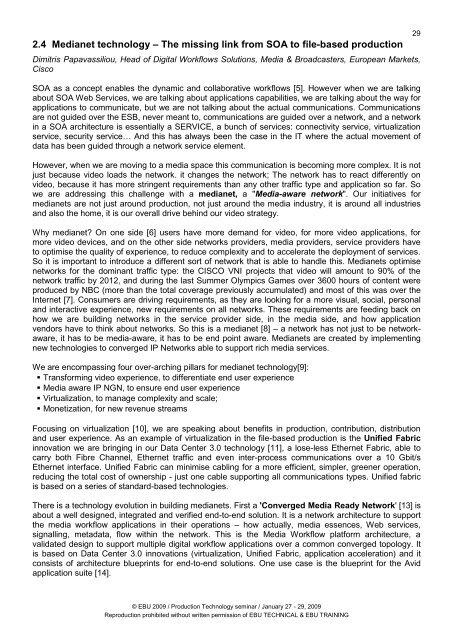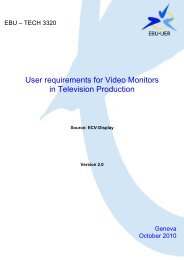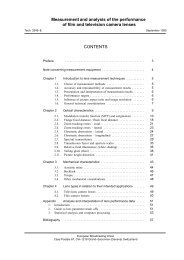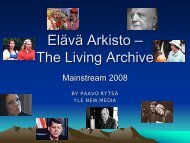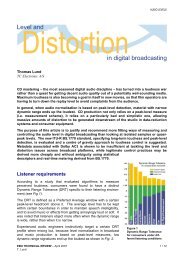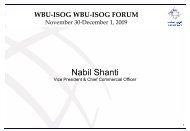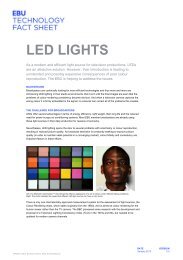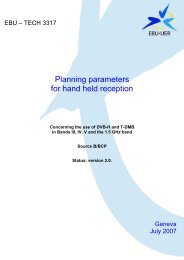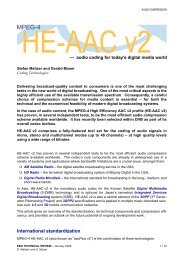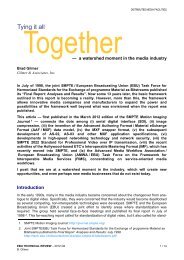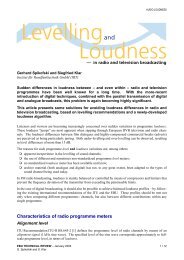Production Technology Seminar 2009 - EBU Technical
Production Technology Seminar 2009 - EBU Technical
Production Technology Seminar 2009 - EBU Technical
You also want an ePaper? Increase the reach of your titles
YUMPU automatically turns print PDFs into web optimized ePapers that Google loves.
2.4 Medianet technology – The missing link from SOA to file-based production<br />
Dimitris Papavassiliou, Head of Digital Workflows Solutions, Media & Broadcasters, European Markets,<br />
Cisco<br />
SOA as a concept enables the dynamic and collaborative workflows [5]. However when we are talking<br />
about SOA Web Services, we are talking about applications capabilities, we are talking about the way for<br />
applications to communicate, but we are not talking about the actual communications. Communications<br />
are not guided over the ESB, never meant to, communications are guided over a network, and a network<br />
in a SOA architecture is essentially a SERVICE, a bunch of services: connectivity service, virtualization<br />
service, security service… And this has always been the case in the IT where the actual movement of<br />
data has been guided through a network service element.<br />
However, when we are moving to a media space this communication is becoming more complex. It is not<br />
just because video loads the network. it changes the network; The network has to react differently on<br />
video, because it has more stringent requirements than any other traffic type and application so far. So<br />
we are addressing this challenge with a medianet, a "Media-aware network". Our initiatives for<br />
medianets are not just around production, not just around the media industry, it is around all industries<br />
and also the home, it is our overall drive behind our video strategy.<br />
Why medianet? On one side [6] users have more demand for video, for more video applications, for<br />
more video devices, and on the other side networks providers, media providers, service providers have<br />
to optimise the quality of experience, to reduce complexity and to accelerate the deployment of services.<br />
So it is important to introduce a different sort of network that is able to handle this. Medianets optimise<br />
networks for the dominant traffic type: the CISCO VNI projects that video will amount to 90% of the<br />
network traffic by 2012, and during the last Summer Olympics Games over 3600 hours of content were<br />
produced by NBC (more than the total coverage previously accumulated) and most of this was over the<br />
Internet [7]. Consumers are driving requirements, as they are looking for a more visual, social, personal<br />
and interactive experience, new requirements on all networks. These requirements are feeding back on<br />
how we are building networks in the service provider side, in the media side, and how application<br />
vendors have to think about networks. So this is a medianet [8] – a network has not just to be networkaware,<br />
it has to be media-aware, it has to be end point aware. Medianets are created by implementing<br />
new technologies to converged IP Networks able to support rich media services.<br />
We are encompassing four over-arching pillars for medianet technology[9]:<br />
� Transforming video experience, to differentiate end user experience<br />
� Media aware IP NGN, to ensure end user experience<br />
� Virtualization, to manage complexity and scale;<br />
� Monetization, for new revenue streams<br />
Focusing on virtualization [10], we are speaking about benefits in production, contribution, distribution<br />
and user experience. As an example of virtualization in the file-based production is the Unified Fabric<br />
innovation we are bringing in our Data Center 3.0 technology [11], a lose-less Ethernet Fabric, able to<br />
carry both Fibre Channel, Ethernet traffic and even inter-process communications over a 10 Gbit/s<br />
Ethernet interface. Unified Fabric can minimise cabling for a more efficient, simpler, greener operation,<br />
reducing the total cost of ownership - just one cable supporting all communications types. Unified fabric<br />
is based on a series of standard-based technologies.<br />
There is a technology evolution in building medianets. First a 'Converged Media Ready Network' [13] is<br />
about a well designed, integrated and verified end-to-end solution. It is a network architecture to support<br />
the media workflow applications in their operations – how actually, media essences, Web services,<br />
signalling, metadata, flow within the network. This is the Media Workflow platform architecture, a<br />
validated design to support multiple digital workflow applications over a common converged topology. It<br />
is based on Data Center 3.0 innovations (virtualization, Unified Fabric, application acceleration) and it<br />
consists of architecture blueprints for end-to-end solutions. One use case is the blueprint for the Avid<br />
application suite [14].<br />
© <strong>EBU</strong> <strong>2009</strong> / <strong>Production</strong> <strong>Technology</strong> seminar / January 27 - 29, <strong>2009</strong><br />
Reproduction prohibited without written permission of <strong>EBU</strong> TECHNICAL & <strong>EBU</strong> TRAINING<br />
29


